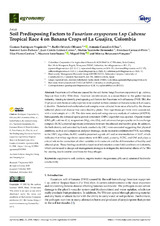Mostrar el registro sencillo del ítem
Soil predisposing factors to fusarium oxysporum f.sp Cubense tropical race 4 on banana crops of La Guajira, Colombia
| dc.contributor.author | Rodríguez-Yzquierdo, Gustavo | |
| dc.contributor.author | Orlando Olivares, Barlin | |
| dc.contributor.author | González-Ulloa, Antonio | |
| dc.contributor.author | León-Pacheco, Rommel | |
| dc.contributor.author | Gómez-Correa, Juan Camilo | |
| dc.contributor.author | Yacomelo-Hernández, Marlon | |
| dc.contributor.author | Carrascal-Pérez, Francisco | |
| dc.contributor.author | Florez-Cordero, Elías | |
| dc.contributor.author | Soto-Suárez, Mauricio | |
| dc.contributor.author | Dita, Miguel | |
| dc.contributor.author | Betancourt-Vásquez, Mónica | |
| dc.date.accessioned | 2023-10-20T10:29:46Z | |
| dc.date.available | 2023-10-20T10:29:46Z | |
| dc.date.issued | 2023 | |
| dc.identifier.issn | 2073-4395 | |
| dc.identifier.uri | http://hdl.handle.net/10396/26080 | |
| dc.description.abstract | Fusarium wilt of banana caused by the soil-borne fungi Fusarium oxysporum f. sp. cubense, Tropical Race 4 (Foc TR4) (Syn. Fusarium odoratissimum), is a major threat to the global banana industry. Aiming to identify predisposing soil factors for Fusarium wilt of banana (FWB) TR4, the 23 physical and chemical soil properties were studied in three commercial banana farms in La Guajira, Colombia. Disturbed and undisturbed soil samples were collected from areas affected by the disease (affected plots) and disease-free areas (healthy plots). Five repetitions per farm were considered, with a total sample of n = 30. The data were analyzed using one-way analysis of variance (ANOVA). Subsequently, the debiased sparse partial correlation (DSPC) algorithm was applied. Organic matter (OM), pH, calcium (Ca), magnesium (Mg), zinc (Zn), and cation-exchange capacity on the exchange complex (ECEC), showed significant differences between the affected and healthy plots. In addition, the bulk density and saturated hydraulic conductivity (HC) were associated suggesting that physical attributes, such as soil compaction and poor drainage, create favorable conditions for FWB. According to the DSPC algorithm, the HC variable presented a grade of 5 and an intermediation of 14.67, which indicates that it has significant associations with BD, sand, porosity, ECEC, and OM and plays a critical role in the connection of other variables in the network and the differentiation of healthy and affected plots. These findings establish a baseline of information under field conditions in Colombia, which can be used to design soil management strategies to mitigate the detrimental effects of Foc TR4 by creating less favorable conditions for the pathogen. | es_ES |
| dc.format.mimetype | application/pdf | es_ES |
| dc.language.iso | eng | es_ES |
| dc.publisher | MDPI | es_ES |
| dc.rights | https://creativecommons.org/licenses/by/4.0/ | es_ES |
| dc.source | Agronomy, 13(10), 2588 (2023) | es_ES |
| dc.subject | Suppressive soil | es_ES |
| dc.subject | Calcium | es_ES |
| dc.subject | Organic matter | es_ES |
| dc.subject | Magnesium | es_ES |
| dc.subject | PH | es_ES |
| dc.subject | Sand | es_ES |
| dc.subject | Saturated hydraulic conductivity | es_ES |
| dc.title | Soil predisposing factors to fusarium oxysporum f.sp Cubense tropical race 4 on banana crops of La Guajira, Colombia | es_ES |
| dc.type | info:eu-repo/semantics/article | es_ES |
| dc.relation.publisherversion | https://doi.org/10.3390/agronomy13102588 | es_ES |
| dc.relation.projectID | Gobierno de España. 1000734 | es_ES |
| dc.rights.accessRights | info:eu-repo/semantics/openAccess | es_ES |

